Dahlia Pinnata Profile: Flower Info, Care & Growing Instructions
Written by Lisa
Dec 11 2021
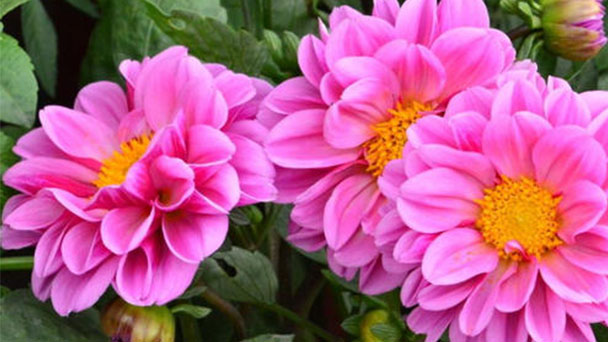
Dahlia Pinnate Picture
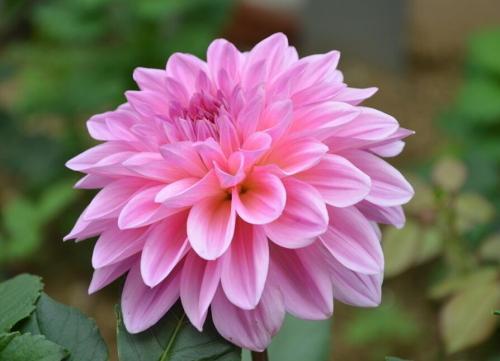
Characteristics of Dahlia Pinnata
The morphology of dahlia pinnate is similar to that of Dali chrysanthemum. It is a dwarf type group of Dahlia varieties, but the plant is relatively short, with a height of only 20 to 60 cm. It is branched and has a flower head. A total pedicel can have several flowers and flower stems. 5 to 7 cm, the flower color is deep red, purple red, pink, yellow, white and other colors. The flower shape is full of changes, and there are single petals and double petals. It can bloom all year round in a suitable environment. It has low plants and long flowering period. The flowering period of Dahlia pinnate is from May to October.
Dahlia Pinnata Growth Conditions
It loves the sun and is suitable for a mild climate. The suitable temperature for growth is 10~25℃. It is afraid of heat and not cold-tolerant. The roots will be frozen at a temperature of 0℃. The growth of plants in hot and rainy areas in summer is stagnant and in a semi-dormant state. Tolerant to drought, more afraid of waterlogging, avoid heavy clay, root rot after being soiled. It requires loose, fertile, and smooth-draining sandy loam, and it is not suitable for planting in low-lying water.
Dahlia pinnate is a flower of the same genus as Dahlia. Its characteristics are similar to that of Dahlia, except that the plant is short, with a plant height of about 20-40 cm, with many branches and flower heads, mostly single-petal small and medium-sized flowers. Each plant can have several flowers and bloom at the same time. Dahlia pinnate likes warm and cool climate, is not tolerant to drought, and is more afraid of waterlogging. Avoid heavy clay soil, and root rot after being soiled. Requires loose, fertile, and smoothly drained sandy loam
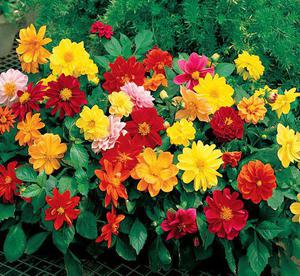
Dahlia Pinnata Distribution
Dahlia pinnate is native to the highlands of Mexico, Guatemala and Colombia.
Dahlia Pinnata Uses
Dahlia pinnate is a perennial herb with gorgeous flower color, scorching, and long flowering period. It has low plants and long flowering period. It is an excellent ground cover plant. It can also be arranged in flower beds, flower borders, etc., and can also be potted for viewing or making Use for cut flowers. The flowers are colorful and the blooming season coincides with the National Day, which is most suitable for family potted plants. Because of its long flowering period, bright and colorful flower colors, and various flower types, it can be used to arrange flower beds and flower paths; it can also be potted for viewing or cut flowers, which is deeply loved by people.
How to Propagate Dahlia Pinnata
Growing Dahlia Pinnata from Seed
Dahlia pinnate is mostly propagated by sowing method, but it is best to use artificial control of the seeds formed by pollination. It can also be propagated by ramets and cuttings. Since Dahlia pinnate is naturally pollinated, the seeds are prone to variation. In order to maintain the excellent characteristics of the seeds, it is best to use artificial pollination. In the north, sowing is usually carried out in early May. Seeds are sowed on-demand or drilled in flower pots or seedbeds. Lightly cover about 0.3 cm. Suitable temperature for germination: 15-20℃, keep humidity and sunshine about 70%, and germinate after 6-8 days. Plant after two leaves. Optimum growth temperature: 18-25℃, transplant 5-7 leaves when transplanting seedlings. Bring the original soil lumps when transplanting seedlings to avoid damaging the roots and facilitating survival. Plant spacing is 20-30cm. In terms of management, Dahlia pinnate likes warm and cool climate and likes sunshine. Avoid heavy soil, loose fertile sandy loam. It has strong adaptability and can grow well under high temperature conditions in summer. The cultivation soil is preferably fertile sandy loam. Good drainage and sunshine are required. Potted plants should avoid standing water, otherwise the bulbs are perishable. Water and fertilization should be reasonable during the growth period. At the same time, sufficient light should be given to make them grow strong and bloom. Water once a day in summer and once every 3-5 days in winter. Compound fertilizer can be applied during the growth period.
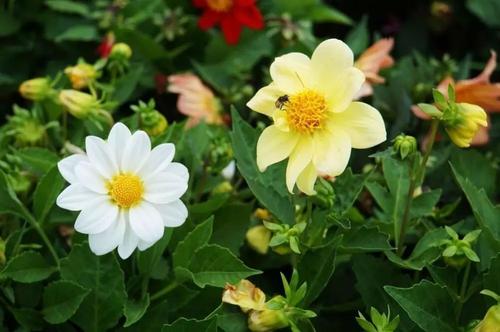
Propagate Dahlia Pinnata from Bulbs
The underground part of Dahlia pinnate flower has bulbs, tubers, etc. After these bulbs grow underground for one year, small balls will grow around it, and these small balls will be separated. Just plant it, simple operation and convenient management. Just be careful not to plant the ball too deep when planting: usually the thickness of the cover soil should not exceed twice the diameter of the ball.
Propagate Dahlia Pinnata from Division
It is best to do it in early spring (February and March) after the soil has thawed. Take the mother plant out of the pot, shake off the excess potting soil, separate the intertwined root system as much as possible, and use a sharp knife to split it into two or more plants. It must have a considerable root system, and its leaves should be properly pruned to facilitate survival.
Soak the divided Dahlia pinnate strains in chlorothalonil 1500 times solution for five minutes before serving. You can also irrigate the roots with chlorothalonil immediately after potting. After the ramets are potted, irrigate the roots or water once. Because its root system has suffered great damage and its water absorption capacity is extremely weak, it takes about 3 to 4 weeks to regenerate new roots. Therefore, watering should be controlled within 3 to 4 weeks after branching to avoid root rot. The transpiration of the leaves is not affected. In order to maintain the water balance of the leaves, it is necessary to spray the leaves 1 to 3 times a day (high temperature and more spray, low temperature and less spray or no spray). Don't pour fertilizer during this time. After dividing the plant, pay attention to the strong sunlight and keep it in the shade shed.
Propagate Dahlia Pinnata from Cuttingd
Dahlia pinnate's top buds, axillary buds and foot buds can all be cut and rooted after germination. The foot buds grow vigorously and have strong resistance to diseases and insects. Generally, the tubers are planted in plain sand pots in early March, kept moist, and placed at room temperature above 15°C to accelerate germination. When the foot bud grows 2 true leaves, cut off the root tuber and insert it into the sand to promote the root, spray water 2 to 3 times a day, and take more than 20 days to take root.
Transplant Dahlia Pinnata
When small Dahlia Pinnata seedlings are installed in pots, a coarse-grained substrate or ceramsite with a thickness of 2 to 2 cm is placed on the bottom of the pot as a filter layer, and a layer of fully decomposed organic fertilizer is sprinkled on it as a base fertilizer. The thickness is about 1 to 2 cm. , And then cover with a layer of substrate, about 1 to 2 cm thick, and then put it into the plant to separate the fertilizer from the root system and avoid root burning. The substrate for the upper basin can be selected from the following one. Vegetable garden soil: slag=3:1; or garden soil: medium-coarse river sand: sawdust (Ru slag)=4:1:2; or one of paddy soil, pond mud, and leaf-humid soil. Or peat + perlite + ceramsite = 2 parts + 2 parts + 1 part; vegetable garden soil + slag = 3 parts + 1 part; peat + slag + ceramsite = 2 parts + 2 parts + 1 part; sawdust + vermiculite + Medium coarse river sand = 2 parts + 2 parts +1 part. After finishing the pot, water it once and place it in a shaded environment for one week. When transplanting small seedlings, first dig the planting hole, and sprinkle a layer of organic fertilizer at the bottom of the planting hole as a base fertilizer (basic fertilizer) with a thickness of about 4-6 cm. Then cover with a layer of soil and put in the Dahlia Pinnata seedlings to mix the fertilizer with Separate the root system to avoid root burning. After putting in the seedlings, backfill the soil, cover the roots, stom on the soil with your feet, and water thoroughly once.
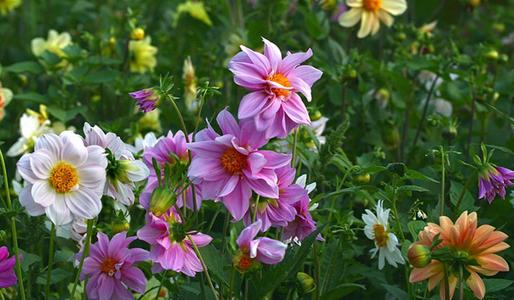
How to Care for Dahlia Pinnata
Dahlia pinnate seeds are sowed on-demand or drilled in flower pots or seedbeds, lightly cover about 0.3 cm, keep humidity and sunshine about 70%, germinate after 6-8 days, and transplant 5-7 of the original leaves. Plant spacing is 20-30cm. The cultivation soil is preferably fertile sandy loam. Good drainage and sunshine are required. Potted plants should avoid accumulation of water, otherwise the bulbs are easy to rot. Water once a day in summer and 3-5 days in winter. Compound fertilizer can be applied during the growth period. .
Dahlia Pinnata Temperature Care
Dahlia pinnate likes cold climates, avoid extreme heat, and grows very slowly in summer; it is not tolerant to frost and will go to sleep when the temperature drops below 10°C. The most suitable growth temperature is 15-28℃. When the daytime temperature does not exceed 28℃ and the temperature difference between day and night is large, it is beneficial to the differentiation of flower buds.
Dahlia Pinnata Lighting Requirements
In the three seasons of late autumn, winter and early spring, because the temperature is not very high, it is necessary to give it direct sunlight to facilitate its photosynthesis and the formation of flower buds, flowering and fruiting. If it encounters high temperature weather or in summer, it needs to block about 30% of the sun. After flowering, put it indoors for maintenance and viewing, and place it near southeast doors and windows to extend the flowering period of Dahlia pinnate and increase the number of flowering as much as possible.
Dahlia Pinnata Watering & Fertilizing
Dahlia pinnate does not require much fertilizer and water, and is also afraid of arbitrarily fertilizing, applying concentrated fertilizers and partial application of nitrogen, phosphorus, and potassium fertilizers. It is required to follow the fertilization principle of "light fertilizer, frequent application, small amount and more frequent, and complete nutrition":
Spring and autumn seasons: These two seasons are the peak seasons for Dahlia Pinnata growth. Fertilizer and water management are cycled in the order of "Fertilizer"-"Fertilizer"-Clear Water-"Fertilizer"-"Fertilizer"-Clear Water ( At least two "flower treasures" should be guaranteed twice a week). The interval period is approximately: 1 to 4 days for outdoor maintenance, shorter intervals during sunny days or high temperature periods, longer intervals during rainy days or low temperature periods, or no watering; In the indoor curing for 2 to 6 days, the interval between sunny days or high temperature period is shorter, and the interval between rainy days or low temperature period is longer or no watering.
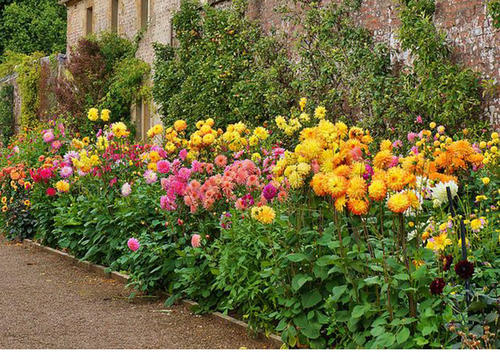
Summer is the season of Dahlia pinnate slow growth, so it is necessary to properly control fertilizer and water. Fertilizer water management circulates in the order of "Fertilizer"-clear water-clear water-"Fertilizer"-clear water-clear water. The interval period is approximately: 1 to 4 days for outdoor maintenance, and the interval is shorter in sunny or high-temperature periods , The interval between rainy days or low temperature period is longer or no watering; 2-6 days in indoor curing, the interval period is shorter during sunny days or high temperature period, and the interval period is longer on rainy days or low temperature period or no watering. Water in the morning or evening when the temperature is low, and spray the plants frequently. Try to arrange the watering time in the morning when the temperature is low.
In the winter dormancy period, the main task is to do a good job of controlling fertilizer and water. Fertilizer and water management should be circulated in the order of "Fertilizer"-clear water-clear water-"Fertilizer"-clear water-clear water. The interval is about 7~ For 10 days, the interval between sunny days or high temperature periods is shorter, and the interval between rainy days or low temperature periods is longer or no watering. The watering time should be arranged as far as possible when the temperature is high at noon on a sunny day.
Dahlia pinnate is not very cold-resistant, and it is difficult to overwinter in the open field north of the Yangtze River. It must be excavated and stored from the end of October to mid-November every year, so that the roots, especially the root neck, will not be damaged when digging. , The sand is hidden in the cellar, one layer of sand and one layer of roots, covered with 20-30 cm of river sand, and then covered with 10 cm of wheat bran to keep it at 3-7°C, the sandy soil is slightly moist, and household sand is buried in a paper box or Move the basin into the room.
In late autumn, winter, and early spring, because the temperature is not very high, Dahlia pinnate must be exposed to direct sunlight to facilitate its photosynthesis and the formation of flower buds, flowering and fruiting. If it encounters high temperature weather or in summer, it needs to block about 30% of the sun. After flowering, put it indoors for maintenance and viewing, and place it near southeast doors and windows to extend the flowering period and increase the number of flowering as much as possible. In the northern region, if you plant in a warm indoor place in early February, flowers will be visible on May 1st, and if you plant in the open field in early July, flowers will bloom before and after the National Day.
Regulates Dahlia Pinnata Flowering
The flowering period of Dahlia pinnate varies from place to place, and generally can bloom continuously for 4 to 5 months. Dahlia pinnate is relatively resistant to heat and is not very sensitive to the length of the sun. In order to adjust the flowering period, you can sown in stages so that as long as the temperature is right, the flowers can bloom continuously throughout the year.
Dahlia Pinnata Disease Control
Powdery mildew damages the Dahlia pinnate leaves, pedicels and flower buds. The first appearance of nearly round white powdery spots, expands into white powdery spots, the leaves are twisted and withered. The bacteria spend the winter on the sick body and spread by airflow. The disease is severe from September to October. In the early stage of the disease, 2% antimycotic 120 aqueous solution 100 to 200 times or 40% polysulfide gel suspension 800 times can be sprayed once every 10 days. Spray 2~3 times.
After the brown spot disease leaves are infected, light yellow dots appear at the beginning, and they expand and sink, and finally form a nearly circular gray-white center with dark brown white spots on the edges, with a round pattern, a diameter of 1 to 5 mm, and a light black mold on the surface. The pathogens will survive the winter in the diseased leaves, and the disease will be severe from June to August. 1% Bordeaux mixture or 75% chlorothalonil 600 times can be used for prevention and treatment.
Viral diseases show symptoms such as mosaic, chlorosis, and dwarfing. The virulence is Dahlia pinnate mosaic virus, cucumber mosaic virus, tomato spotted wilt virus, tobacco streak virus, etc. Leafhoppers and aphids transmit toxins. Non-toxic propagation materials can be used for prevention and control to prevent and control insects.
Dahlia pinnate moth larvae are light yellow or light red, and occur 2~3 generations per year. The larvae are infested for 6~8 months. Spray 50% pine borer 1000 times. For example, if the stems are eaten by insects, omethoate 100~ 200 times.
Read Next:
Top 10 Most Beautiful Roses in the World
Top 10 Most Beautiful Flowers in the World
26 Best Autumn Flowers to Plant for Fall Color in Garden
Latest Updated
- Benefits of Bugleweed - 7 Science-backed Health Benefits
- Bugleweed Dangers & Side Effects - Is It Poisonous?
- How to Plant Evergreen Trees - What You Should Know
- When to Plant Evergreens - Grow Guide for Evergreen Trees
- 12 Wonderful Evergreen Shrubs for Your Garden
- 12 Popular Evergreen Plants with Pictures for Beginners
- When And How To Prune A Lilac Bush Like a Pro
- How to Grow & Care for Lilac Vine (Hardenbergia Violacea)
- Japanese Lilac Tree (Syringa Reticulata) Care & Propagation Guide
- Shumard Oak Pros and Cons - What to Know
Popular Articles
- Winter maintenance of Antirrhinum Majus
- How to Grow Terminalia Mantaly Tree
- How to Grow and Care for Crossostephium Chinense
- How to grow Antirrhinum Majus in spring
- Peristeria Elata (Dove Orchid) Profile: Info & Care Guide
- Underwatered Snake Plant (Sansevieria Trifasciata) - Signs And How To Fix
- How to Care for Brazilian Jasmine Plant (Mandevilla Sanderi)
- How to Grow & Care for Graptopetalum Purple Delight in Summer
- Rosa Chinensis (China Rose): Plant Growing & Care Tips
- How to Care for Baby Sun Rose (Aptenia Cordifolia)